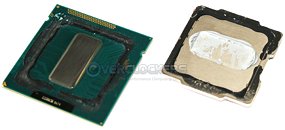Wednesday, April 25th 2012

Ivy Bridge Temperatures Could Be Linked To TIM Inside Integrated Heatspreader: Report
PC enthusiasts with Ivy Bridge engineering samples, and reviewers at large have come to the consensus that Ivy Bridge is a slightly warmer chip than it should be. An investigation by Overclockers.com revealed a possible contributing factor to that. Upon carefully removing the integrated heatspreader (IHS) of an Ivy Bridge Core processor (that nickel-plated copper plate on top of the processor which makes contact with the cooler), the investigator found common thermal paste between the CPU die and the IHS, and along the sides of the die.
In comparison, Intel used flux-less solder to bind the IHS to the die on previous-generation Sandy Bridge Core processors in the LGA1155 package. Attempting to remove IHS off a chip with flux-less solder won't end well, as it could rip the die off the package. On the other hand, the idea behind use of flux-less solder in CPU packages is to improve heat transfer between the die and the IHS. Using thermal paste to do the job results in slightly inferior heat transfer, but removing IHS is safer. One can be sure that making it safe for IHS removal couldn't have been the issue behind switching back to conventional thermal paste, as everything under the IHS isn't user-serviceable anyway, and off limits for them. Perhaps Intel kept extreme overclockers in mind.
Source:
Overclockers.com
In comparison, Intel used flux-less solder to bind the IHS to the die on previous-generation Sandy Bridge Core processors in the LGA1155 package. Attempting to remove IHS off a chip with flux-less solder won't end well, as it could rip the die off the package. On the other hand, the idea behind use of flux-less solder in CPU packages is to improve heat transfer between the die and the IHS. Using thermal paste to do the job results in slightly inferior heat transfer, but removing IHS is safer. One can be sure that making it safe for IHS removal couldn't have been the issue behind switching back to conventional thermal paste, as everything under the IHS isn't user-serviceable anyway, and off limits for them. Perhaps Intel kept extreme overclockers in mind.

97 Comments on Ivy Bridge Temperatures Could Be Linked To TIM Inside Integrated Heatspreader: Report
Even if we say the savings is only say 1 cent per processor, Intel has shipped 75 Million+ Sandybridge processors, and likely will ship close to that number if not more Ivy Bridge processors. So that is a huge savings. One cent on 75 Million processors is $750,000. That is a nice chunk off the bottom line for a change that won't affect but maybe 10% of users.
But that is the way of the world today. Money, money, money.
Common sense be damned.
I know what I've read. We're not talking about stock speeds.
Wiki: "Indium is used as a thermal interface material in the form of pre-shaped foil sheets fitted between the heat-transfer surface of a microprocessor and its heat sink. The application of heat partially melts the foil and allows the indium metal to fill in any microscopic gaps and pits between the two surfaces, removing any insulating air pockets that would otherwise compromise heat transfer efficiency."
Intel Patent(2010)-Methods of fabricating robust integrated heat spreader designs
Personally, I am very happy to have my 2500K with proper thermal material in it. Even if it doesn't matter.
It does in fact matter. Don't think people would have started this thread, or written articles about it if it didn't matter to at least a few people.
If it doesn't matter to you, I can live with that. But I'm not going to agree with you.
For the cost of the salary of a few overpaid executives, they cause what should be an easily overclockable chip to become a very hot chip.
So I don't agree that it makes sense for them to do this.
So, yes, if it saves them money and it doesn't affect the overwhelming majority of users, it makes perfect sense.
But to be honest, if I'm not encoding, I just run at stock with the rad fans turned down for silence. I only load up my OC profile for heavy encoding anymore. Even my slower IPC 980x is more than enough for most tasks (including gaming @ 1920x1200) for me not to bother.You remove the metal socket retention mechanism and use a bolt through kit when you delid. The die sticks up past the actual socket once the bracket is removed.
kingpincooling.com/forum/showthread.php?t=1730
Same temps with or without IHS. Paste isn't the issue.
dunno, I just remember having a 92C E4300 that is still alive today in a friends rig... like 5 years later.
So what is all the fuss I read about increased temperatures? I certainly do not see the proof when it comes to my Ivy Bridge compared vs. old reviews on Sandy Bridge. (Different intel stock coolers might contribute a few degrees differences)